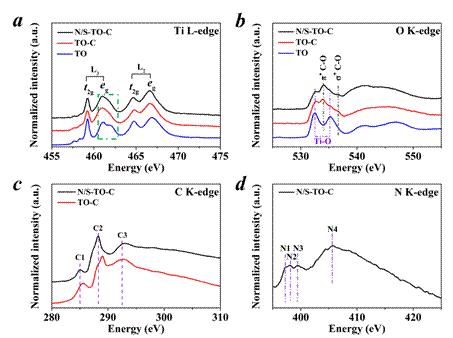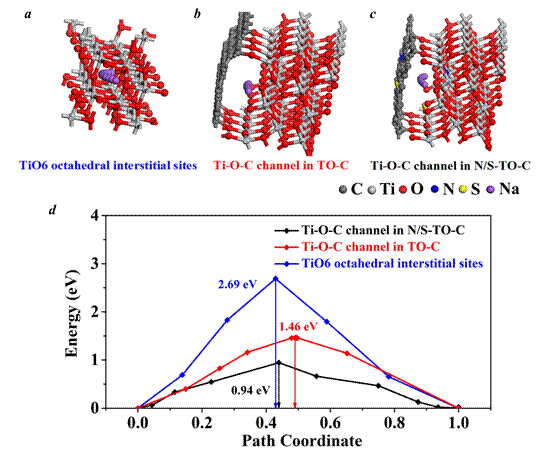| Optimize sodium storage performance of anatase TiO2 by constructing Ti–O–C channels |
| From: PublishDate:2020-07-31 Hits: |
Based on the increasing energy demand and the accounting of energy storage cost, sodium ion batteries are expected to be used in large-scale energy storage systems and have attracted intense attention of researchers. Anode material is a key factor to determine the electrochemical performance of sodium ion batteries. Anatase TiO2 possesses good structural stability and long cyclic performance as Na+ insert and extract in the interstitial sites stacked by TiO6 octahedra with small volume change. The sodium storage mechanism of insertion/extraction controlled by diffusion process leads to the slow electrochemical reaction kinetics. The pseudocapacitance reaction with fast charge/discharge characteristic can overcome the slow kinetics of anatase TiO2. Meanwhile, the structural change of pseudocapacitance reaction is almost negligible during the electrochemical reaction with a relatively low energy barrier. In this work, in situ combination of TiO2 and carbon was achieved by pyrolysis of tetrabutyl titanate and polyvinylpyrrolidone at high temperature, and Ti–O–C sodium storage channels were formed at the two-phase interface. Using thiourea as the doping source, heteroatom N and S were introduced to induce surface defects on the graphite layer to accelerate the mass transfer of Na+ from the surface carbon layer to the near-surface Ti–O–C channels. The sodium storage mechanism of the as-prepared N/S co-doped TiO2/C composite nanofibers electrode is dominated by surface pseudocapacitance.
Figure 1 XAS spectra of (a) Ti L-edge, (b) O K-edge, (c) C K-edge, and (d) N K-edge Synchrotron radiation X-ray absorption spectra (XAS) were recorded at the photoelectron spectroscopy station (4B9B, Beijing Synchrotron Radiation Facility) to obtain the absorption spectra of Ti L-edge, O K-edge, C K-edge and N K-edge. The peak attributed to carbon atoms attached to oxygen, suggesting the formation of Ti–O–C bonds. Based on this, first principles calculations further verified the low energy barrier for Na+ insertion/extraction in the Ti-O-C channels formed by the intimately integrated graphite layer with TiO2 near the surface. This paper was published in “ACS appl. mater. interfaces, 2019, 11(19): 17416-17424”.
Figure2 Sodium diffusion in (a) TiO6 octahedral interstitial channel, (b) Ti-O-C channel in TO-C, (c) Ti-O-C channel in N/S-TO-C; (d) migration activation energy of Na+ diffusion in the above channels Article: Wei Song, Hanqing Zhao*, Jianqi Ye, Mengmeng Kang, Siyu Miao, Zhong Li*. Pseudocapacitive Na+ Insertion in Ti–O–C Channels of TiO2–C Nanofibers with High Rate and Ultrastable Performance. ACS Applied Materials & Interfaces, 2019, 11:17416-17424. |
|
|
| Chinese
- Metal-free efficient photocatalyst for stable visible water splitting——Top ten major scientific progresses in China in 2015
- The nano-resolution imaging platform was awarded the first rate prize of Beijing Science and Technology in 2014
- Beamline 1W1 of BSRF started to runoperate in the couplingparasitic mode of BEPCII
- Synthesis of High Performance Polymer Materials for Field Effect-Transistors
- Surfactant molecular aggregates in green solvents
- GIXRD has played an important role in the characterization of organic thin-film transistors
Copyright © 2011 - 2012 Beijing Synchrotron Radiation Facility



